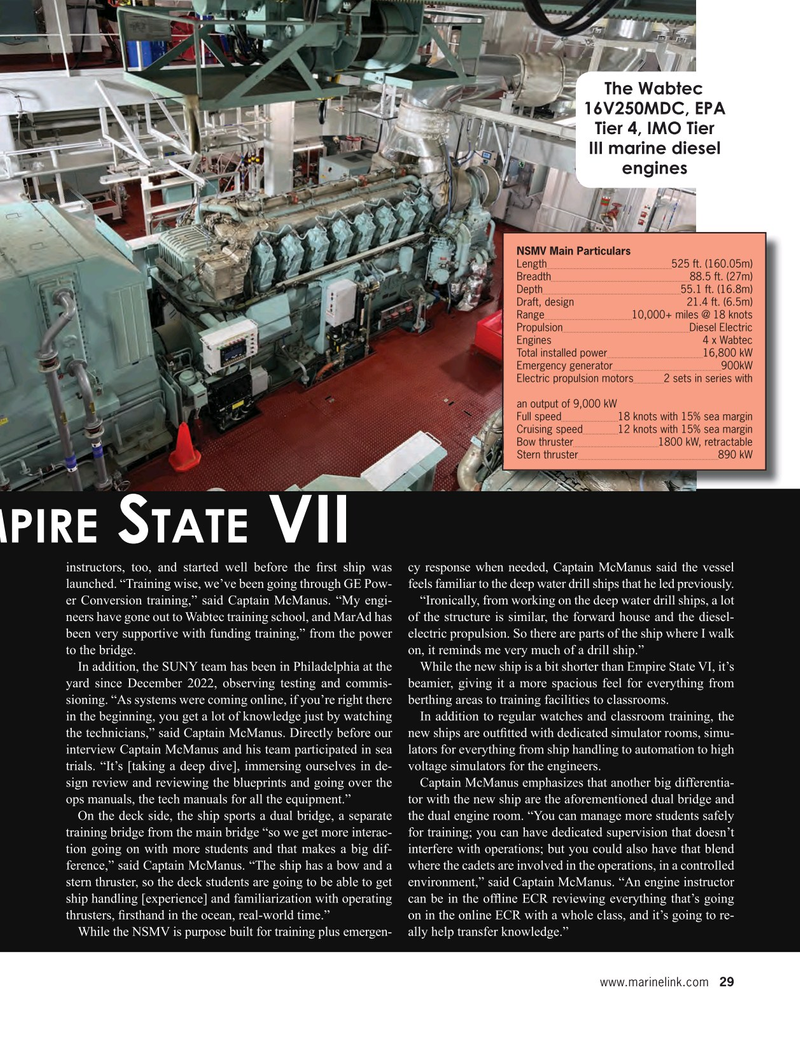
Page 29: of Maritime Reporter Magazine (December 2023)
Great Ships of 2023
Read this page in Pdf, Flash or Html5 edition of December 2023 Maritime Reporter Magazine
The Wabtec 16V250MDC, EPA
Tier 4, IMO Tier
III marine diesel engines
NSMV Main Particulars
Length 525 ft. (160.05m)
Breadth 88.5 ft. (27m)
Depth 55.1 ft. (16.8m)
Draft, design 21.4 ft. (6.5m)
Range 10,000+ miles @ 18 knots
Propulsion Diesel Electric
Engines 4 x Wabtec
Total installed power 16,800 kW
Emergency generator 900kW
Electric propulsion motors 2 sets in series with an output of 9,000 kW
Full speed 18 knots with 15% sea margin
Cruising speed 12 knots with 15% sea margin
Bow thruster 1800 kW, retractable
Stern thruster 890 kW
MPIRE TATE S VII instructors, too, and started well before the ? rst ship was cy response when needed, Captain McManus said the vessel launched. “Training wise, we’ve been going through GE Pow- feels familiar to the deep water drill ships that he led previously. er Conversion training,” said Captain McManus. “My engi- “Ironically, from working on the deep water drill ships, a lot neers have gone out to Wabtec training school, and MarAd has of the structure is similar, the forward house and the diesel- been very supportive with funding training,” from the power electric propulsion. So there are parts of the ship where I walk to the bridge. on, it reminds me very much of a drill ship.”
In addition, the SUNY team has been in Philadelphia at the While the new ship is a bit shorter than Empire State VI, it’s yard since December 2022, observing testing and commis- beamier, giving it a more spacious feel for everything from sioning. “As systems were coming online, if you’re right there berthing areas to training facilities to classrooms.
in the beginning, you get a lot of knowledge just by watching In addition to regular watches and classroom training, the the technicians,” said Captain McManus. Directly before our new ships are out? tted with dedicated simulator rooms, simu- interview Captain McManus and his team participated in sea lators for everything from ship handling to automation to high trials. “It’s [taking a deep dive], immersing ourselves in de- voltage simulators for the engineers. sign review and reviewing the blueprints and going over the Captain McManus emphasizes that another big differentia- ops manuals, the tech manuals for all the equipment.” tor with the new ship are the aforementioned dual bridge and
On the deck side, the ship sports a dual bridge, a separate the dual engine room. “You can manage more students safely training bridge from the main bridge “so we get more interac- for training; you can have dedicated supervision that doesn’t tion going on with more students and that makes a big dif- interfere with operations; but you could also have that blend ference,” said Captain McManus. “The ship has a bow and a where the cadets are involved in the operations, in a controlled stern thruster, so the deck students are going to be able to get environment,” said Captain McManus. “An engine instructor ship handling [experience] and familiarization with operating can be in the of? ine ECR reviewing everything that’s going thrusters, ? rsthand in the ocean, real-world time.” on in the online ECR with a whole class, and it’s going to re-
While the NSMV is purpose built for training plus emergen- ally help transfer knowledge.” www.marinelink.com 29
MR #12 (18-33).indd 29 12/5/2023 1:27:45 PM

 28
28

 30
30
